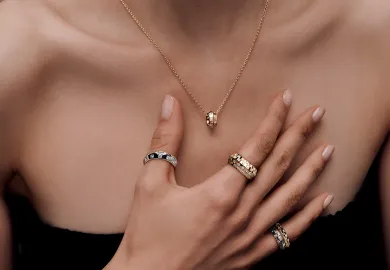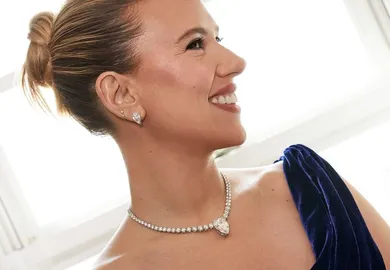
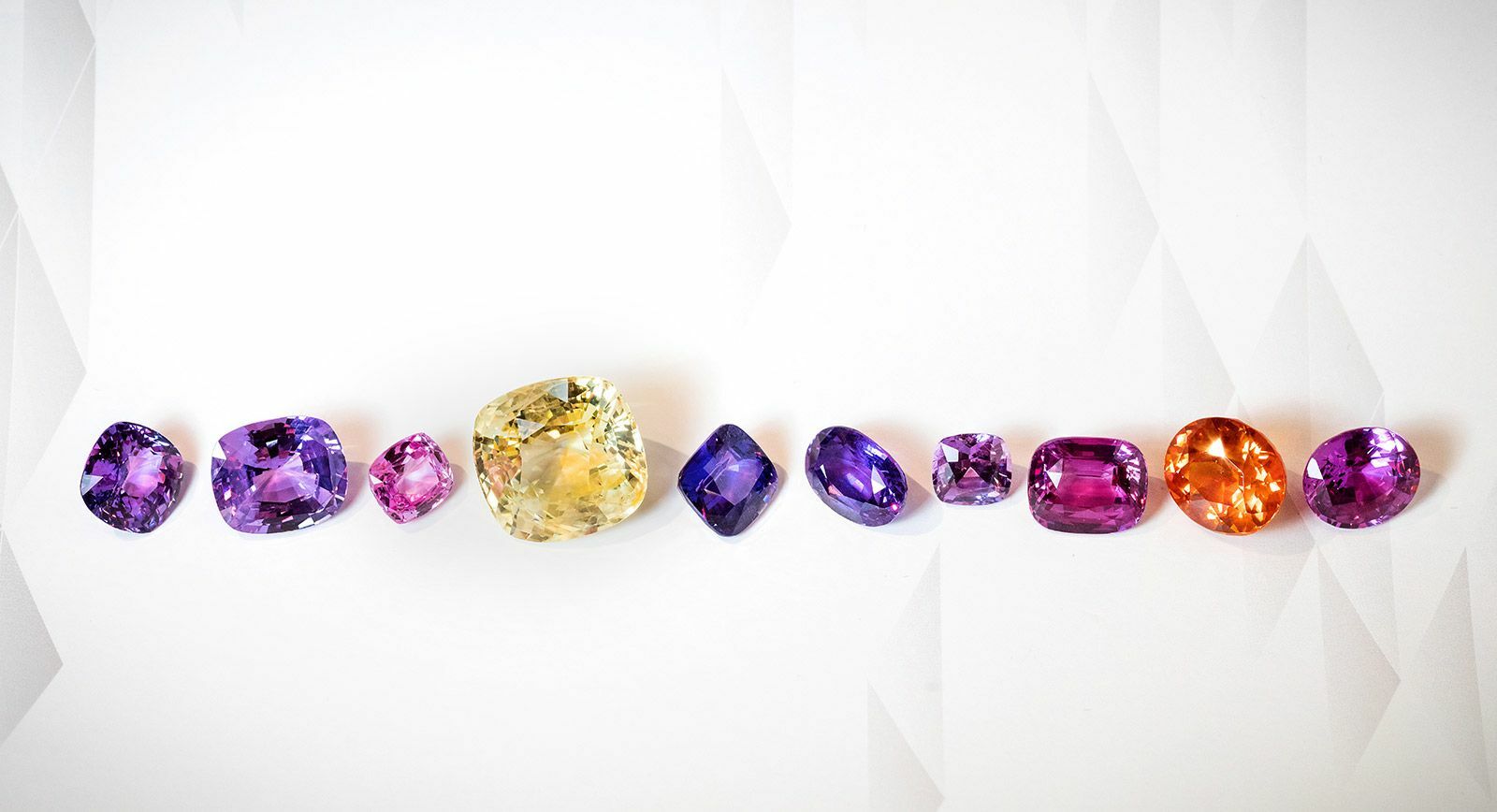
Fancy Colour Sapphires: What is it about them that Constantin Wild finds so enchanting?
Alongside rubies and emeralds, sapphires are one of the most valuable gemstones in the world. Of all of the available delineations of sapphire – historically – dark blue sapphires were considered most desirable among jewellery lovers and gem collectors. The increasing popularisation of precious stones in all the colours of the rainbow means that demand for other shades of corundum has rapidly grown in recent years.
Hot pink, purple, orange, yellow, grey and even green sapphires have piqued the interest of both fledgling designers and leading brands, becoming more and more prevalent in the fine jewellery designs of each. At a recent exhibition in Hong Kong, coloured sapphires were the focus of my conversation with Constantin Wild, the famous gem cutter from the German town of Idar-Oberstein.
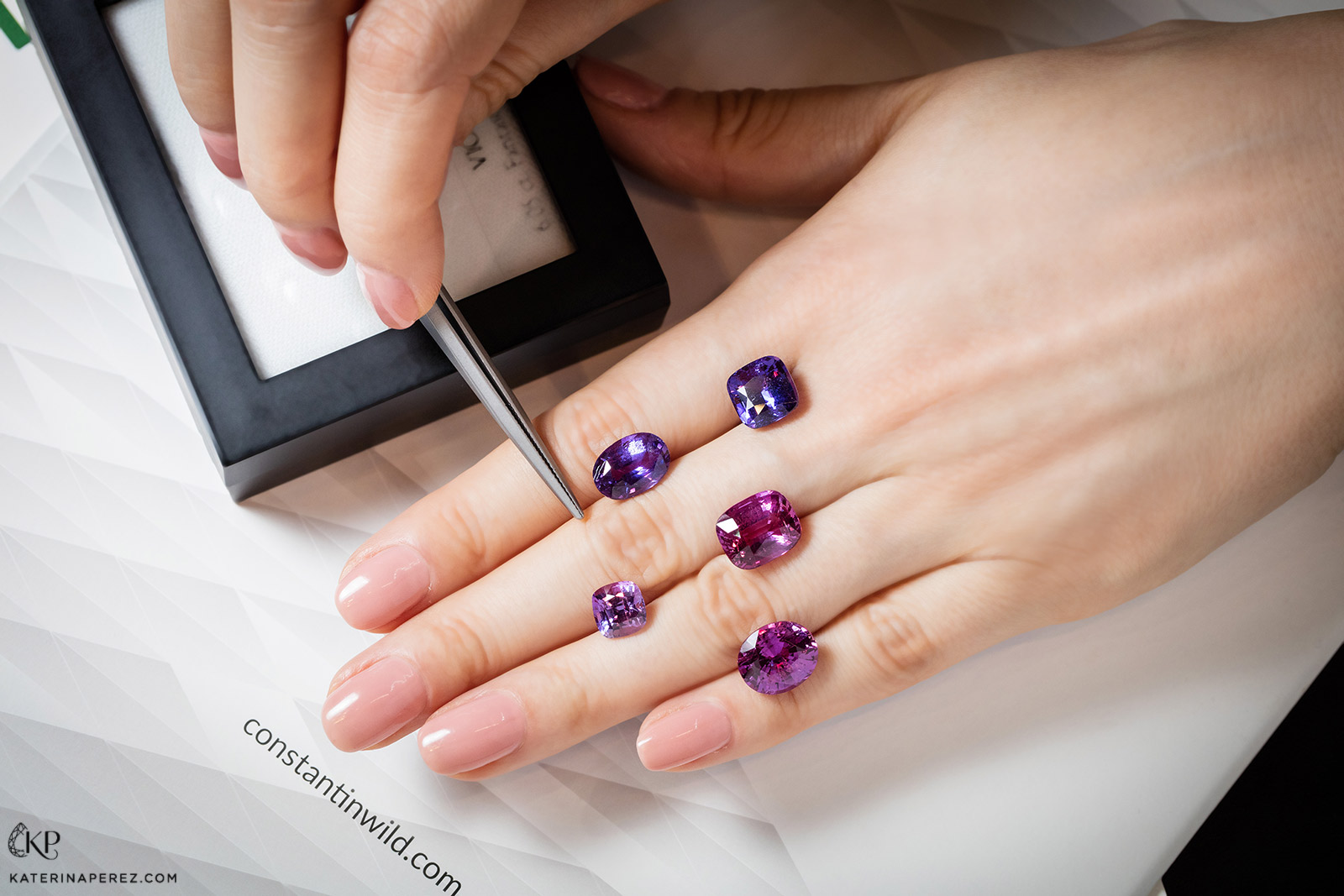
A selection of fancy coloured purple hue sapphires in a variety of cuts from Constantin Wild. Photo by Simon Martner
As Constantin laid out boxes bursting with sapphires of various colours in front of me, he began our ensuing absorption into the world of these enchanting stones with the words: “most consumers are unaware of the wide palette of sapphire colours, as the market in these fancy coloured stones is very limited. There is a strong perception that sapphires should be blue – as if all roses should be red – which of course is not always the case!”
Corundum owes its rich colour palette to its chemical composition – and every hue has its own. Initially colourless aluminium oxide comes into contact with iron, chrome, vanadium or titanium, which then forms a mineral that produces a red (rubies also below to the corundum family), dark blue, bright pink, orange-pink, yellow, greenish or purple colour.

A selection of fancy coloured sapphires in a variety of cuts from Constantin Wild. Photo by Simon Martner
Chrome produces a red corundum, titanium turns the gem dark blue, and iron and vanadium make it yellow or green. In order to achieve a wide spectrum of colours and tonality, mother nature creates different combinations of chemical elements – with the oxide composition potentially containing two or three. As a result of this, sapphires of every shade imaginable – featuring different levels of colour saturation – are formed.

A selection of fancy coloured sapphires in a variety of cuts from Constanin Wild
“I personally love orange and purple sapphires; and specifically, the type of orange which exhibits a juicy Mandarin colour. It is so fresh and fashionable. Violet and purple are the hues that I also admire a lot because there is such an extensive range of different shades: some are more pastel; others are saturated and velvety. A greyish undertone can add mystery and excitement to them,” explains Constantin.
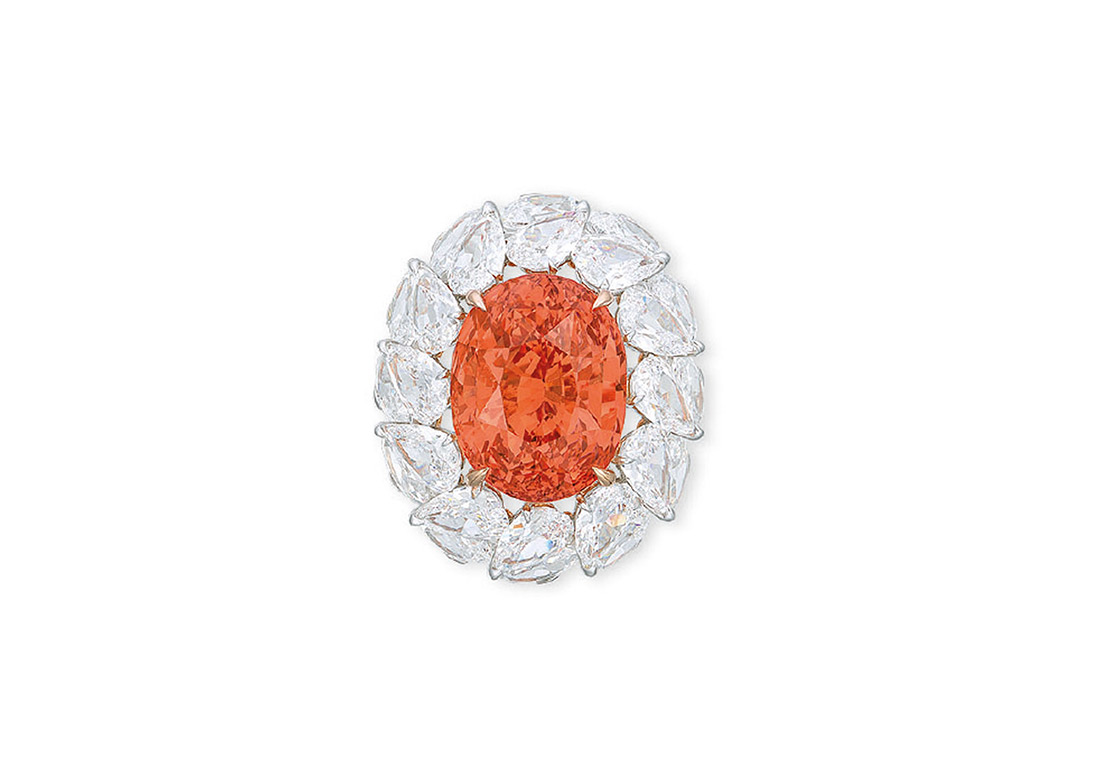
Ring with oval Sri Lankan Padparadscha sapphire of 28.04 carats auctioned at Christie’s in November 2017
Among the wide array of corundum varieties, there is a stone which stands out – one with a unique pink-orange colour that has been given its own name: Padparadscha, which translated from Sanskrit means either ‘sunrise’ or ‘sunset’, but can also mean ‘the colour of a lotus flower’. It is only extracted in very small quantities from Sri Lankan mines, making it a truly valuable rarity. As a reference point, a ring with an oval Sri Lankan gemstone weighing 28.04 carats was auctioned at Christie’s in November 2017 and sold for roughly $88,000 per carat ($2,470,000 in total). 12 years before that, another ring with an oval Padparadscha sapphire weighing 20.84 carats was sold at auction for less than a quarter of that sum ($18,000 per carat).

Ring with oval Padparadscha sapphire weighing 20.84 cts sold at Christie's in 2005
Padparadscha can be something of outstanding beauty, but today the definition of the Padparadscha colour is a certificate game – gemmological laboratories define the colour range at their own discretion. Personally, I would only buy pink-orange sapphires for their beauty and not for what it says on the certificate – if there is one accompanying the stone. – Constantin Wild
Indeed, the price tag on coloured sapphires is enormously dependent on the beauty of the stone, with the colour itself playing a leading role in its determination: the tint needs to be deep and bright, not too light or too dark. Add to that good clarity, a quality cut, and of course the weight – the bigger it is, the more expensive. There’s another equally important factor to consider before making a purchase: the presence of a gemmological certificate. Uniquely, Wild offers his clients a ‘Gemstone Portrait’ to accompany his major stones: documentation in which you can find the requisite facts about the history of the gemstone – including a professional photo and gemmological data such as material, variety, cut, size, and a brief description of what is special – in his opinion – about that particular gemstone.

A selection of fancy coloured sapphires in a variety of cuts from Constantin Wild. Photo by Simon Martner
Constantin Wild did not only show me corundums of amazing colours, but also a cabochon cut purple sapphire that demonstrates what gemmologists refer to as ‘asterism’. On the surface of this rare star sapphire stone, weighing 29 carats, 6 rays of light cross it equidistantly as you move the gem, reacting to the light. The effect is caused by the reflection of light through miniature inclusions which appear as microscopic ‘needles,’ darting in different directions and creating this ‘star’ emitting from the centre of the gemstone. Most star sapphires display 6 light rays, and these become especially visible if a light is shone on the sapphire.

Constantin Wild cabochon cut 29 carat fancy purple star sapphire. Photo by Simon Martner
Hopefully, those for whom this article was an introduction to the world of fancy sapphires will be intrigued to find out more on this gemstone in the future.

WORDS
Katerina Perez is a jewellery insider, journalist and brand consultant with more than 15 years’ experience in the jewellery sector. Paris-based, Katerina has worked as a freelance journalist and content editor since 2011, writing articles for international publications. To share her jewellery knowledge and expertise, Katerina founded this website and launched her @katerina_perez Instagram in 2013.
Related Articles
Latest Stories
Add articles and images to your favourites. Just

Century of Splendour:Louis Vuitton Awakened Hands, Awakened Minds Chapter II
Creative Director Francesca Amfitheatrof offers her unique interpretation of a pivotal period in France’s history, marked by the French Revolution, the Napoleonic era, and the rise of industrialism
Jewels Katerina Perez Loves
Continue Reading

Writing Adventures:Co-Authoring the Book
Paraiba: The Legacy of a Color
Brand Focus: Louis Vuitton
Jewellery Insights straight to your inbox







































